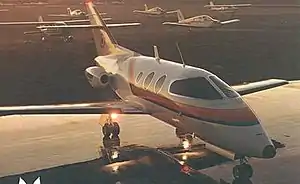Foxjet ST600
The Foxjet ST600 was a small business jet under development in the United States in the late 1970s. Problems with development, particularly in finding a suitable powerplant, caused the project to be abandoned before any substantial work on the prototype had been done, but the concept proved to be ahead of its time, foreshadowing the very light jets of thirty years later.
| ST600 | |
|---|---|
 | |
| Role | Light business jet |
| Manufacturer | Tony Team Industries |
| Status | Abandoned project |
| Number built | None |
Design and development
The ST600 was of familiar business jet configuration, with a low wing, cruciform tail, swept flying surfaces, and engines mounted on pods on the sides of the rear fuselage. The intentions of the project were to create a practical business jet small enough and light enough to take advantage of smaller airfields at a cost of around half of what full-size business jets of the day were selling for. Fuel costs were touted as being as low as nine cents a mile in 1977, compared to fifty cents a mile or higher for contemporary aircraft.[1]
73 orders for the aircraft were taken with Bill Lear ordering the first example.
Three mockups were constructed and were widely displayed at aviation shows around the United States in the late 1970s by Tony Fox with slipping first flight schedules.[2][3] The project got as far as Foxjet contracting Aeronca to construct the prototype. The engines, however, proved a major stumbling block. The tiny Williams Research type WR44 turbofan that had made the project possible received certification for use in a passenger-carrying aircraft, but due to its selection as the powerplant for cruise missiles, the United States government blocked non-military use of the engine. Without a suitable alternative available, the project could not proceed.
In 2006, a Foxjet mockup was exhibited at the AOPA expo at Palm Springs, Florida by Millennium Aerospace, which had purchased rights to the design in May. The company announced plans to resurrect the design and market it with Pratt & Whitney Canada PW615 engines.
The original prototype was eventually purchased by Lyle Anderson, of Princeton, Minnesota from a used motorcycle dealership in Minneapolis and prior to that, it stood in front of a car dealership. In 2010 it was put in Anderson's front yard, and was a participant in the Rum River Festival parade prior to relocation to Princeton Airport.[4]
Specifications (as designed)
Data from Jane's All The World's Aircraft 1980–81[5]
General characteristics
- Crew: 1–2
- Capacity: 4–5 passengers
- Length: 31 ft 10 in (9.70 m)
- Wingspan: 31 ft 8 in (9.64 m)
- Height: 10 ft 3 in (3.12 m)
- Wing area: 125.0 sq ft (11.61 m2)
- Aspect ratio: 8:1
- Empty weight: 2,408 lb (1,092 kg)
- Max takeoff weight: 4,550 lb (2,064 kg)
- Fuel capacity: 218 US gal (830 L)
- Powerplant: 2 × Williams Research WR44-800 turbofan, 850 lbf (3.8 kN) thrust each
Performance
- Cruise speed: 410 mph (660 km/h, 360 kn) (max cruise), 329 mph (286 kn; 529 km/h) (normal cruise)
- Stall speed: 85 mph (137 km/h, 74 kn) (flaps down)
- Range: 1,400 mi (2,300 km, 1,200 nmi)
- Service ceiling: 41,000 ft (12,000 m)
- Rate of climb: 3,400 ft/min (17 m/s)
- Take-off run to 50 ft (15 m): 2,700 ft (820 m)
- Landing run from 50 ft (15 m): 1,860 ft (570 m)
See also
Aircraft of comparable role, configuration, and era
References
- "9 cent a mile executive business jet". Popular Science. October 1977.
- Cliff Barnett (22 August 1977). "Oshkosh Sport Aircraft Galore" (PDF-2.3 Mb). FLIGHT International: 573-. ISSN 0015-3710. Retrieved 1 June 2014.
- Air Progress. 40 (No. 11): 94. November 1978. Missing or empty
|title=(help) (40th Anniversary Issue) - "Foxjet Now a Historic Lawn Ornament". EAA. 13 May 2010. Archived from the original on 16 May 2010. Retrieved 8 July 2019.
- Taylor 1980, p. 338.
- "Aeronca to Build Foxjet". Flight International. 28 January 1978. p. 230. Retrieved 2008-03-27.
- Field, Hugh; Mike Hirst (15 October 1977). "America's big-business show". Flight International. pp. 1117–1118. Retrieved 2008-03-27.
- "Foxjet delayed". Flight International. 7 April 1979. p. 1047. Retrieved 2008-03-27.
- "Foxjet: low cost, high style". Flight International. 21 May 1977. p. 1402. Retrieved 2008-03-27.
- "Foxjet to fly in January, says Fox". Flight International. 24 June 1978. p. 1911. Retrieved 2008-03-27.
- Goodman, Warren (2 July 1977). "Business before pleasure at Reading 1977". Flight International. p. 22. Retrieved 2008-03-27.
- Taylor, John W. R., ed. (1980). Jane's All The World's Aircraft 1980–81. London: Jane's Publishing Company. ISBN 0-7106-0705-9.
- Taylor, Michael J. H. (1989). Jane's Encyclopedia of Aviation. London: Studio Editions. p. 411. ISBN 0-7106-0710-5.
